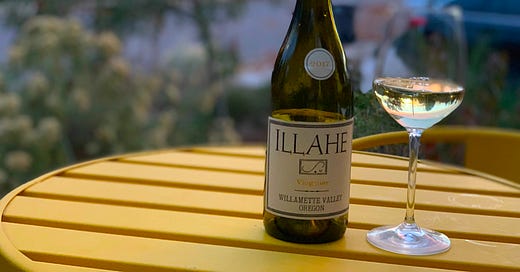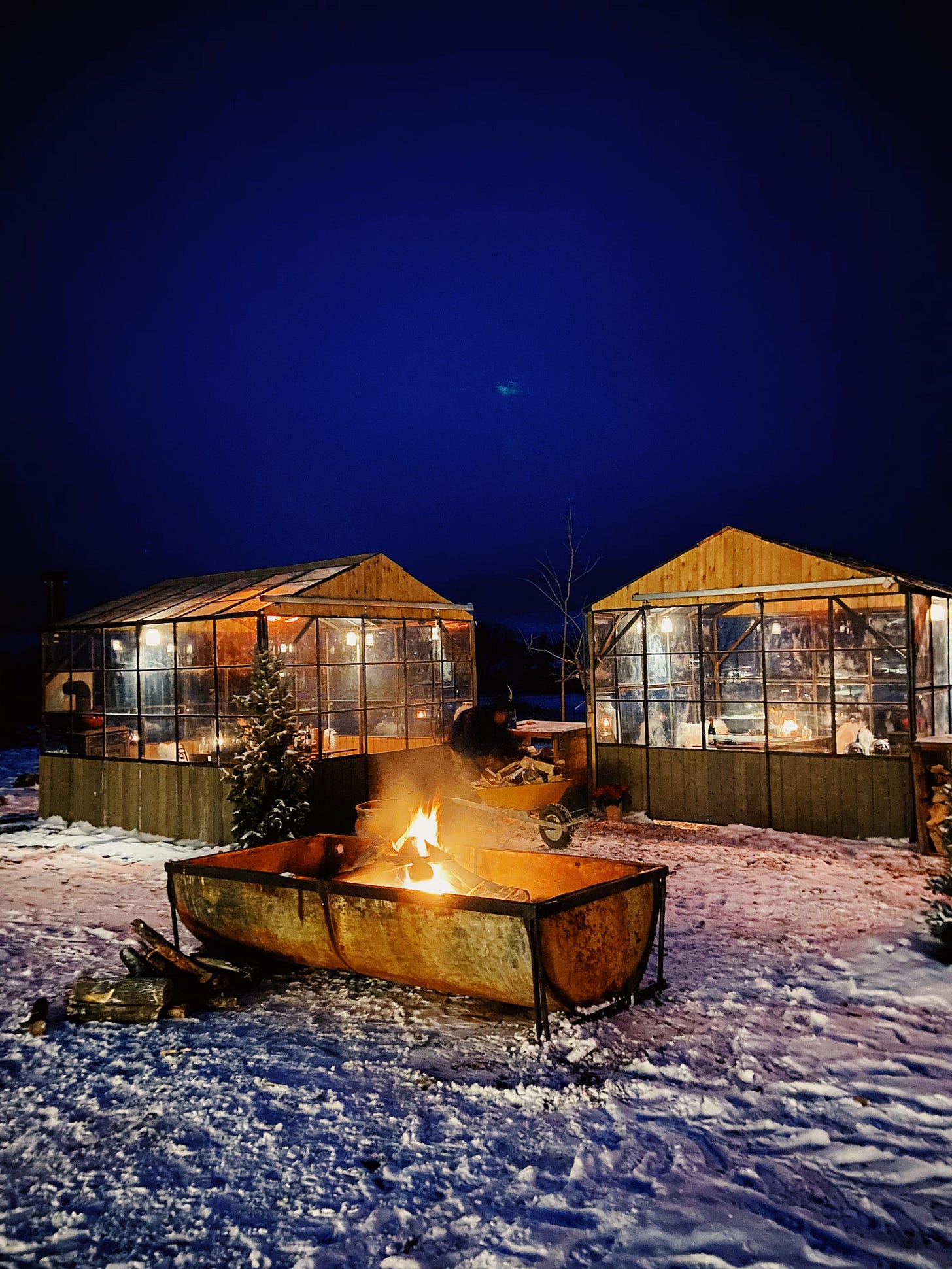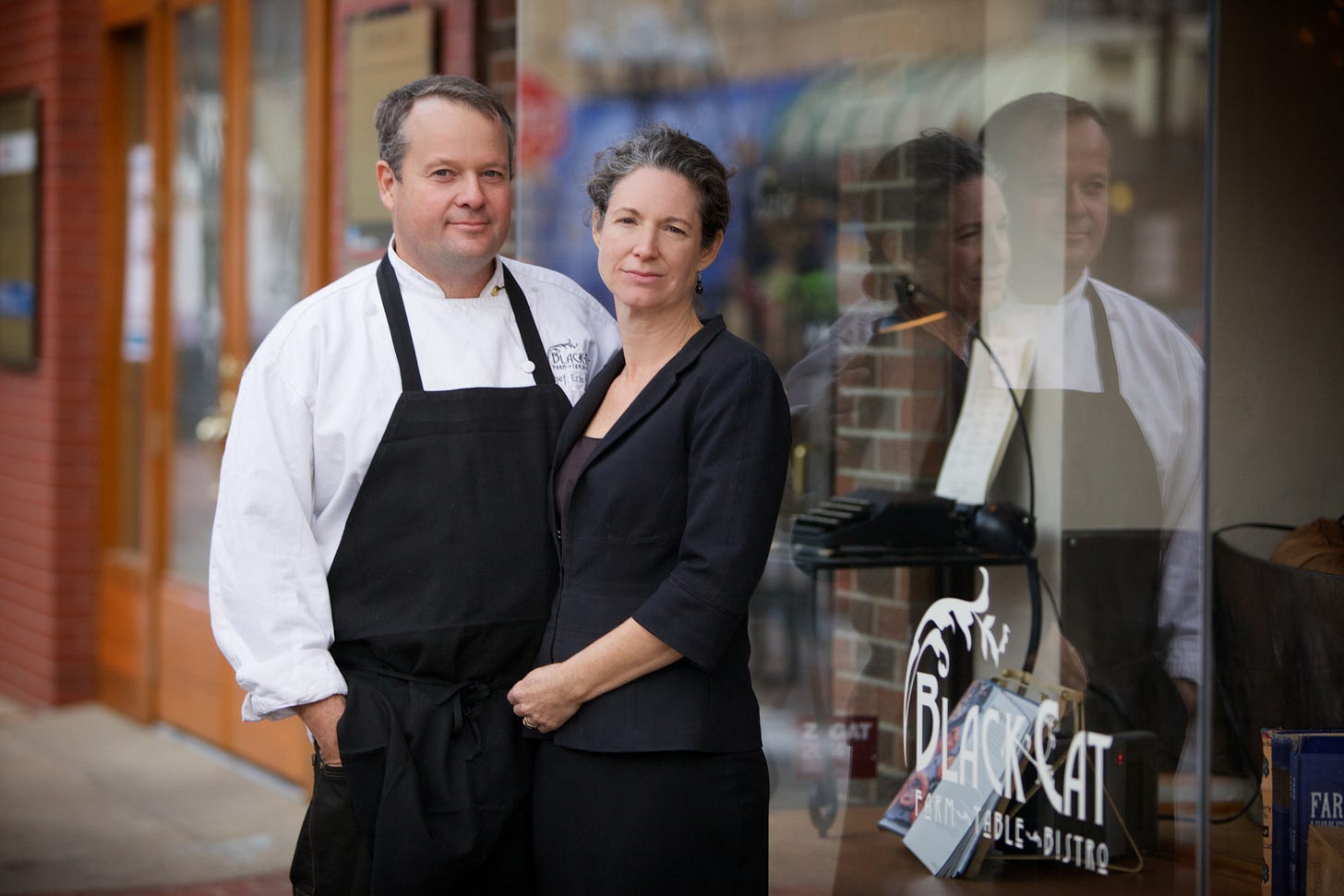
Happy National Drink Wine Day, friends.
This week’s Letter From the Forest deals mostly with the stuff of soil. Our trail briefly passes through a winery, winds rather exhaustively through an organic farm-to-table operation, and offers a view of a fungi-based alt-meat incorporating organisms from Yellowstone National Park microbes.
For a couple of years leading up to COVID, I wrote a weekly column in my hometown newspaper, The Daily Camera, called Drinking With Doug. I spent a fair bit of time navigating Boulder’s thriving brewery and distillery landscape, but was crazy for wine. While the County’s erratic and punishing climate prevented classic wine grapes — Vitis vinifera — from thriving, it contained an unusual number of grape nuts and wine-interesting bars and restaurants. I piloted my way between the winey spots with keen interest.
Within the wine world, I learned some people identified as being part of the “natural wine movement.” The movement didn’t offer a consistent definition of natural wine. But all stabs at codifying the term included sustainable approaches towards farming grapes and crafting wine.
Many wineries embraced by the natural wine crowd follow biodynamic farming practices, meaning (among other things) toxic pesticides and herbicides are forbidden. They also tend to care for the land between and beneath the rows, cultivating habitat for insects and wildlife and nurturing vibrant soil. Winemakers don’t add much to their grape juice other than yeast, often wild yeast.
If you raise a glass tonight, and plan on masking up and heading to a liquor store, consider some of the wineries that pay close attention to sustainability. One easy-to-find winemaker, Illahe Vineyards in Oregon, devotes resources to things like water use, salmon protection, and fossil fuel consumption. A pair of horses, for example, mow the property and transport grapes from vine to winery.
The esteemed British wine writer Jancis Robinson offers an entire series of free videos and articles about sustainability. It’s worth checking out. Finally, most good liquor stores hire wine nerds. If you are hunting for more sustainable wines, find one of those nerds. They’ll steer you in healthy directions.
Cheers, friends.
Black Cat Organic Farm - A Community’s Heart
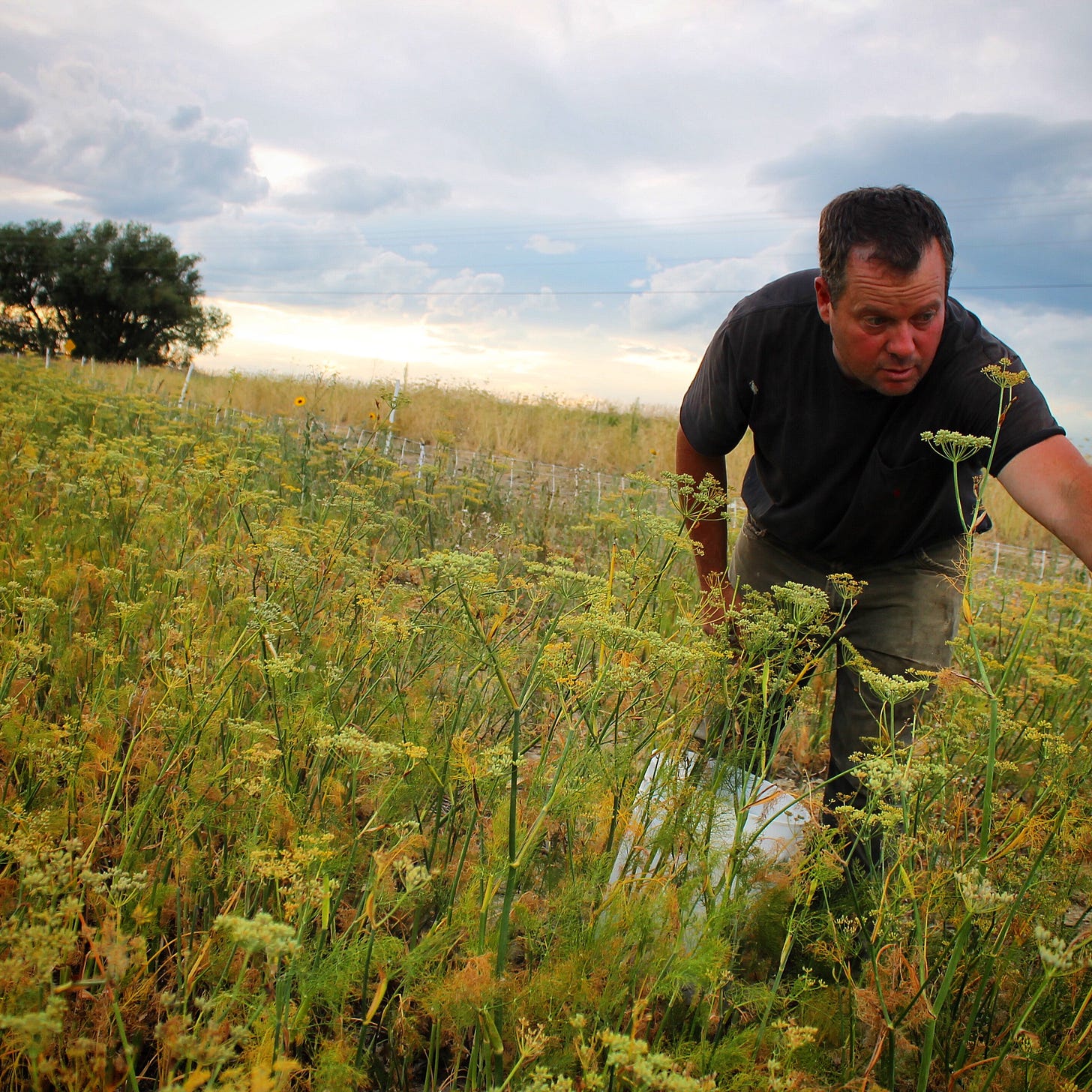
It’s hot, nearly 100 degrees, and here stands the chef in his straw hat and sandals, nearly entangled in the riot of green that at some point will cease being the stuff growing around the front door of his house and become part of someone’s meal.
The chef, Eric Skokan, had been up since 8 a.m., toiling in the heat. In just a few hours, he would move from the outdoor blaze to that of his tiny restaurant kitchen, where he would stand before flaming stoves and pots of boiling water until midnight or so.
In the summer, at least, this is the world of Skokan, the owner of Black Cat restaurant in Boulder: garden, restaurant, garden, restaurant.
“This year it’s all starting to come together,” says Skokan, who opened Black Cat about 18 months ago. “It’s been big dreams and a lot of work.”
That’s the opening lines of my first piece about Eric in The Denver Post, from August of 2008. Five years later, after a decade of feature writing at the Post, much of it about food and agriculture, I left the paper and joined what was then my wife, Annie’s, PR firm. Black Cat was my first client. It’s been my excellent fortune that we have worked together ever since.

I’ve watched Eric and his wife, Jill, expand far beyond the gardens flanking their old rental house in North Boulder, where I first met them. Black Cat Organic Farm now involves 425 acres of cultivated fields and pasture for sheep and pigs.
The operation grows its own heritage grains, and mills them into flours. It includes a permanent farm stand, a Boulder County Farmers’ Market stand and a thriving farm dinner space. Black Cat grows more than 250 kinds of vegetables, legumes, grains and herbs, everything from tomatoes to artichokes to asparagus, kale, cilantro and sesame seeds. Yes, for a time at least, sesame seeds.
The Black Cat team pursues preservation techniques — fermentation, sun-drying, freezing, root cellaring — with zeal. The fields undulate in a harsh climate similar to the steppes of Central Asia. Santa Monica it ain’t. Things don’t grow year-round, but Eric and Jill desire restaurants largely free from Sysco delivery trucks and New Zealand kiwis wrapped in plastic. So they grow, and they preserve. Depending on the season, somewhere between 85% and 95% of the food on the plate comes from nearby fields.
The farm supports two restaurants, Black Cat Bistro and Bramble & Hare. A permanent farm stand, as well as a stand at the Boulder County Farmers’ Market. A CSA. And a thriving farm dinner venue on their historic, pastoral property which during the 19th century served as the blacksmith shop for the Swedes who moved from Minnesota to Boulder to raise dairy cattle.
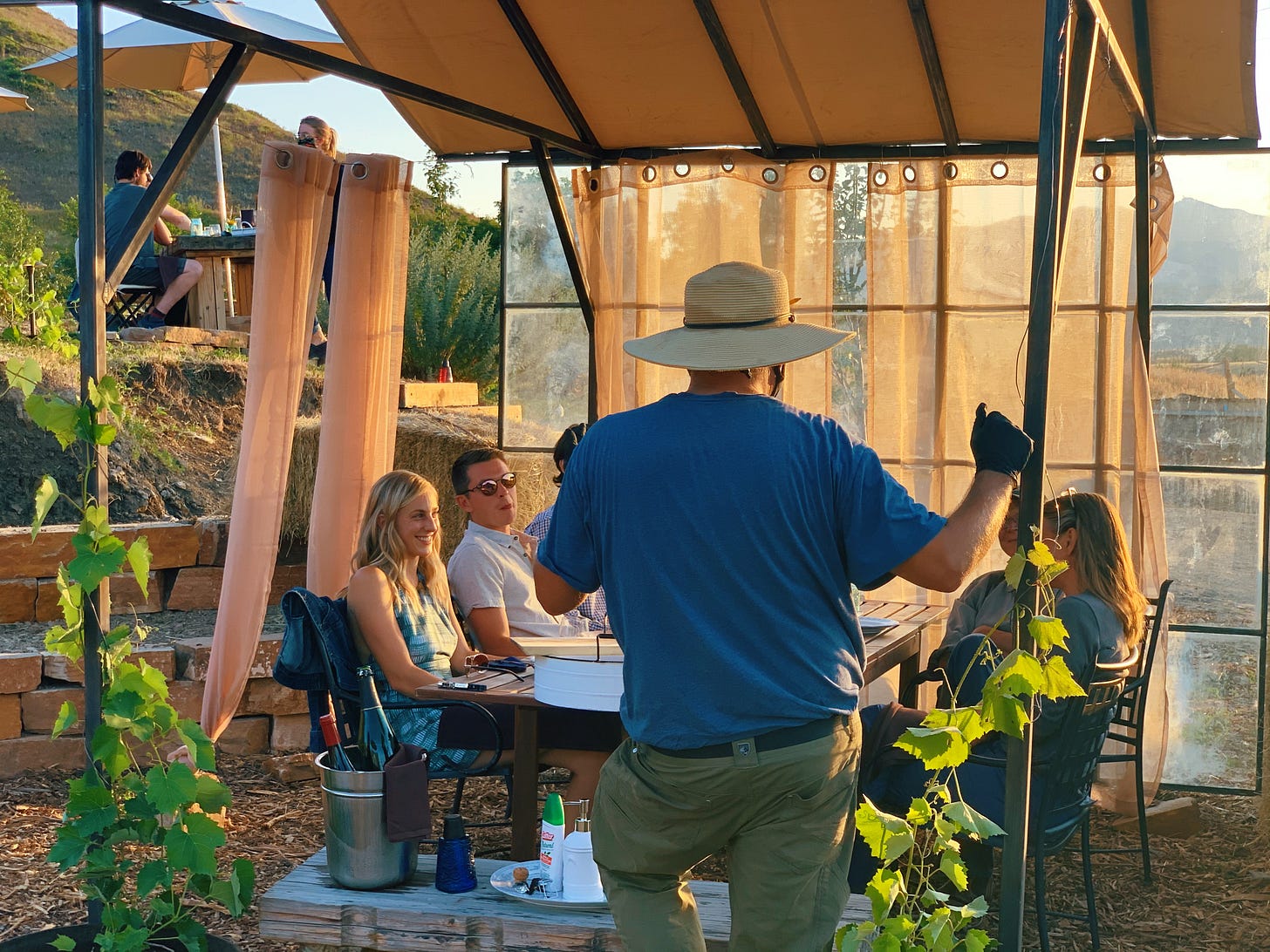
As Black Cat's PR guy, I have devoted a good bit of time researching other farm-to-table outfits. Unless I have missed something, no other operation comes close in terms of scope and ambition. That includes the most famous of them all, Stone Barns Center for Food & Agriculture in New York State. The Center, created by billionaire David Rockefeller and captained by chef Dan Barber, supplies some of the food for two restaurants, one on the property and the other in New York City. Vegetable cultivation is about 6 acres. Another 300 acres on the Rockefeller State Park Preserve is used for grazing.
Eric and Jill built the most expansive farm-to-table operation in the United States, with at least 50 acres of vegetable cultivation, through years of grit, risk, failures and successes. They taught themselves how to perform all of the agricultural work — planting and nurturing crops, grazing livestock, milling flours from grains, operating a greenhouse and on and on — through online research, conversations with farmers, YouTube videos and much trial and error.
We all routinely encounter the phrase “farm-to-table.” Unfortunately, it doesn’t mean anything. A restaurant can grow some herbs on the roof and tend to a scattering of tomato and cucumber plants out back, and call itself farm-to-table. It can work closely with local farmers, but grow nothing itself, and (rightfully) champion its farm-to-table ethos.
And then you have Black Cat, where nearly everything on the plate — the bread, the spinach salad, the pork belly app, lamb chop, mint coulis and roasted beets — comes from fields no more than 5 miles from the restaurants. All of it planted, nurtured, harvested, preserved and prepared by Black Cat’s team of farm and restaurant pros.
It’s tough enough running a few restaurants. Toss in growing hundreds of kinds of vegetables, raising livestock, milling grains, preserving harvests and the rest of it, and it’s like moving from calculus to quantum physics.
Black Cat’s accomplishments stagger me. So do the challenges.
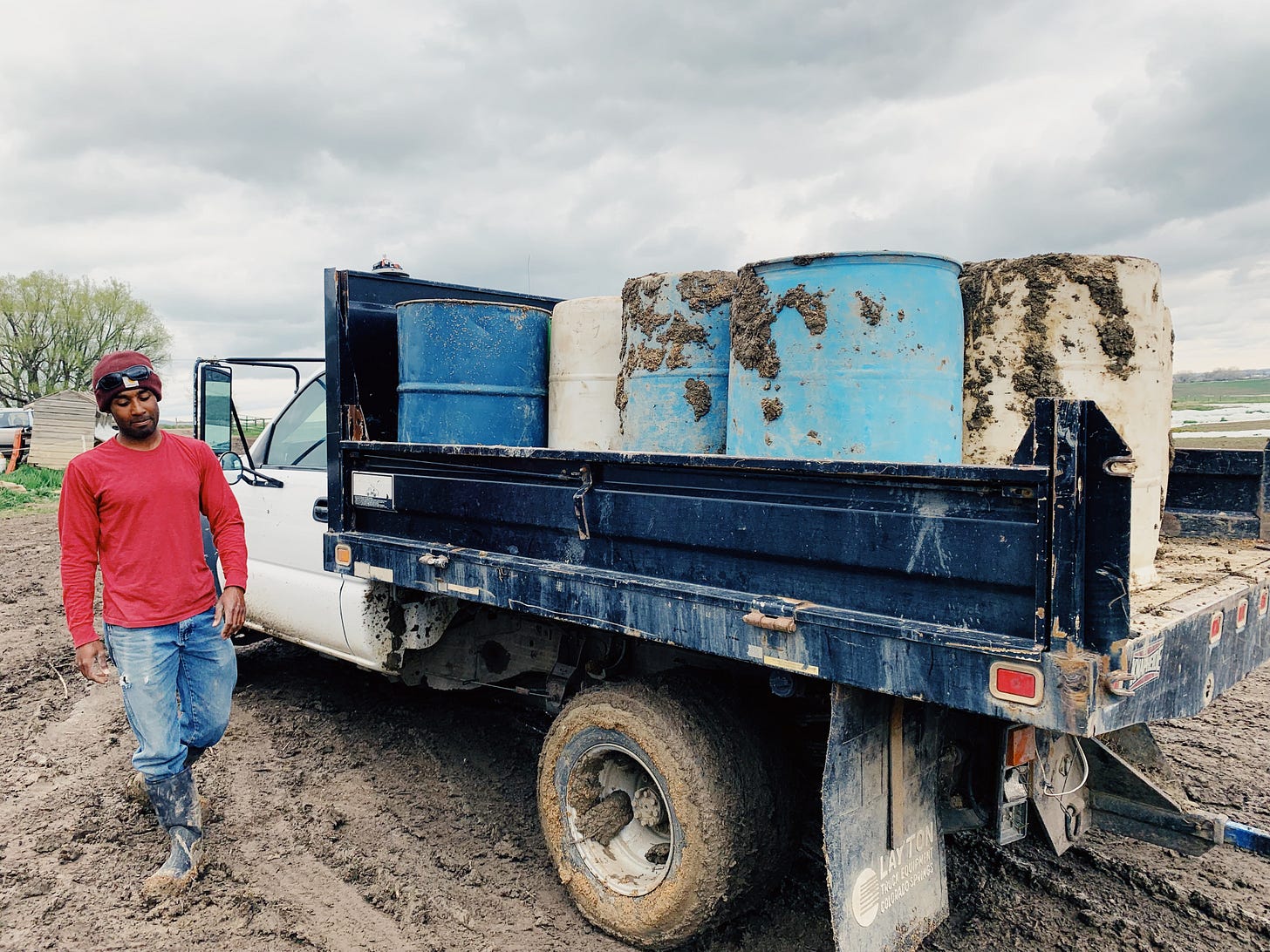
I was still with the Post when historic floods in 2013 submerged many of their fields. When the rains finally stopped, they thought all had been destroyed. But they leaned into grit, leased more farm land and expanded.
I witnessed so many setbacks over the years: mice ravaging the year’s supply of Belgian endive that Eric had planted in a 100-foot-long trench; the loss of an entire carrot crop due to an employee blunder; geese pecking through row cover and eating tens of thousands of dollars worth of spinach and other crops. Tractors, most of them vintage, need constant repair. Frosts, drought and floods loom as daily existential threats.
Pests and diseases always threaten. As organic farmers, the Skokans don’t prosecute them with pesticides and herbicides, which is the easy approach. Instead they rely on beneficial insects and organic-approved tactics. It is not the easy approach.
They embraced regenerative organic agriculture, too, a set of food-growing practices that revolve around soil vitality. Rather than treating soil merely as a growing medium, regenerative organic agriculture views it as an ecosystem, like a forest, estuary or tundra rolling into the horizon.
Conventional agriculture kills ecosystems; in many ways, violent destruction serves as its foundation. Corn and soybean farmers, among others, aim for zombie soil — something embodying a familiar appearance, but dead inside. Rather than relying on the soil to provide food to plants — not a possibility, as the soil is deceased and barren of nutrients — conventional ag uses “inputs,” like fertilizer. It saturates fields with toxic chemicals to rid it of bugs and weeds, of life.
Organic agriculture stands as a huge improvement. Most chemicals are forbidden, for example. Regenerative organic takes things a bit further, focusing more explicitly on soil health. Where improved soil quality often aligns with organic farming, soil vibrancy dwells more explicitly at the heart of regenerative agriculture. It is pursued with more intention.
A colorful, well-wrought story in yesterday’s New York Times, set in the Texas Panhandle town where loads of Annie’s relatives settled, explores regenerative agriculture. While the story allows for plaudits for the style of farming, it also casts doubt on some of the claims for its ability to turn agricultural fields into carbon sinks. Scientists undoubtedly will continue researching whether regen does more than improve soil — whether it also could serve as a climate-change-fighting tool.
The Skokan’s pursued regenerative agriculture because they understand the power of healthy soil. They also honored its potential to store carbon. Prior to their regen experiments, they had been engaging with biodynamic agriculture, another style of soil-first farming that we discussed in the earlier piece about wine.
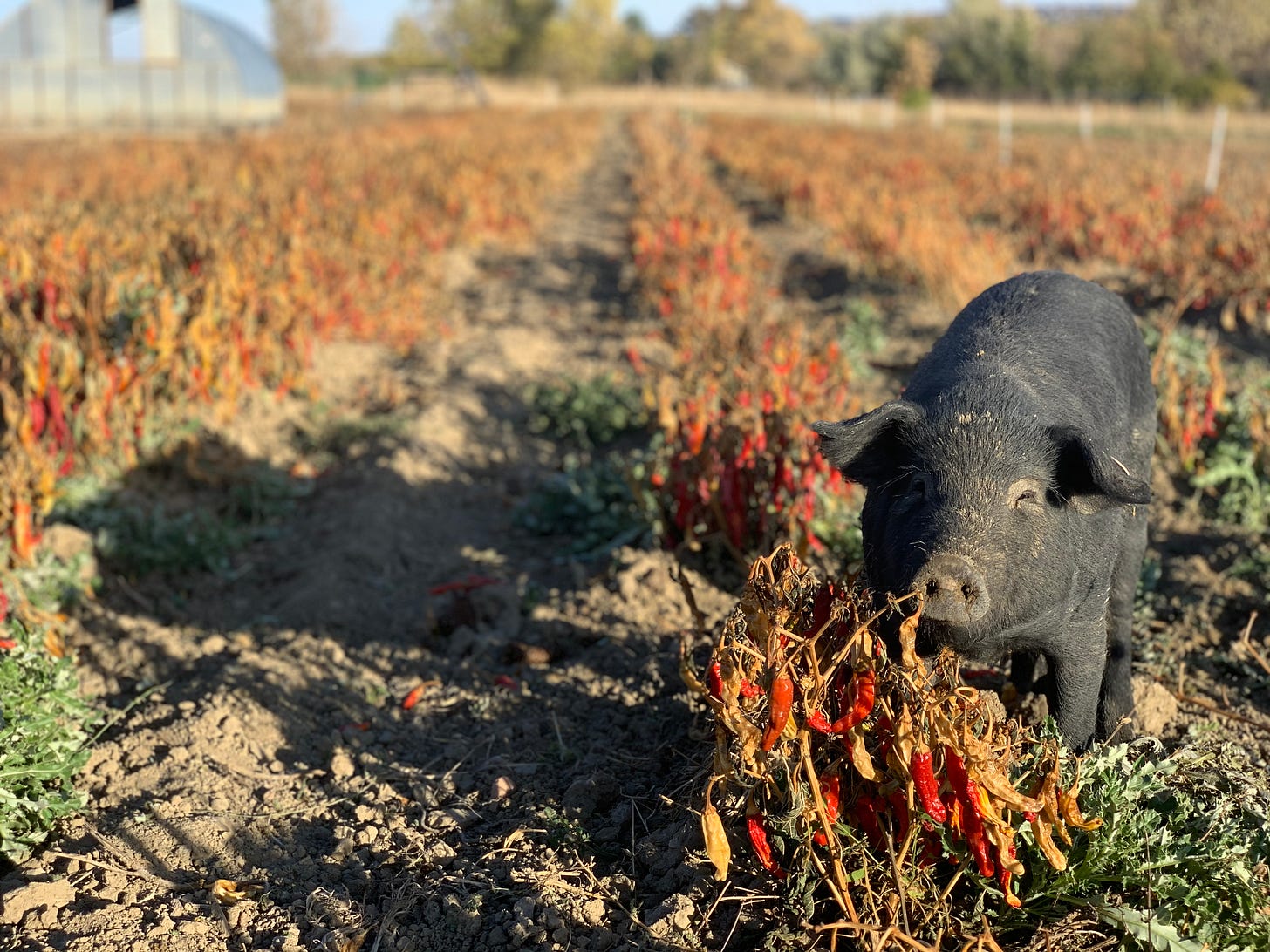
I remember the first year they planted pepper plants at scale, probably six years ago. By September, the heart of pepper-harvesting season, most of the fruit was scrawny and withered. Fast-forward a few years, after several crop rotations and the incorporation of pigs into the fields, and peppers on the same fields broadcasted vigor.
Hurdles, like those disconsolate peppers circa. 2014, have been many. But Eric and Jill have leapt over them all. Eric almost savors the setbacks as learning opportunities. Failure sinks in with much more staying power than tips from a YouTube video.
Nearly 15 years after they opened Black Cat, the sprawling operation is successful. It should serve as a model for other restaurants desiring more intimate and sustainable attachments to agriculture.
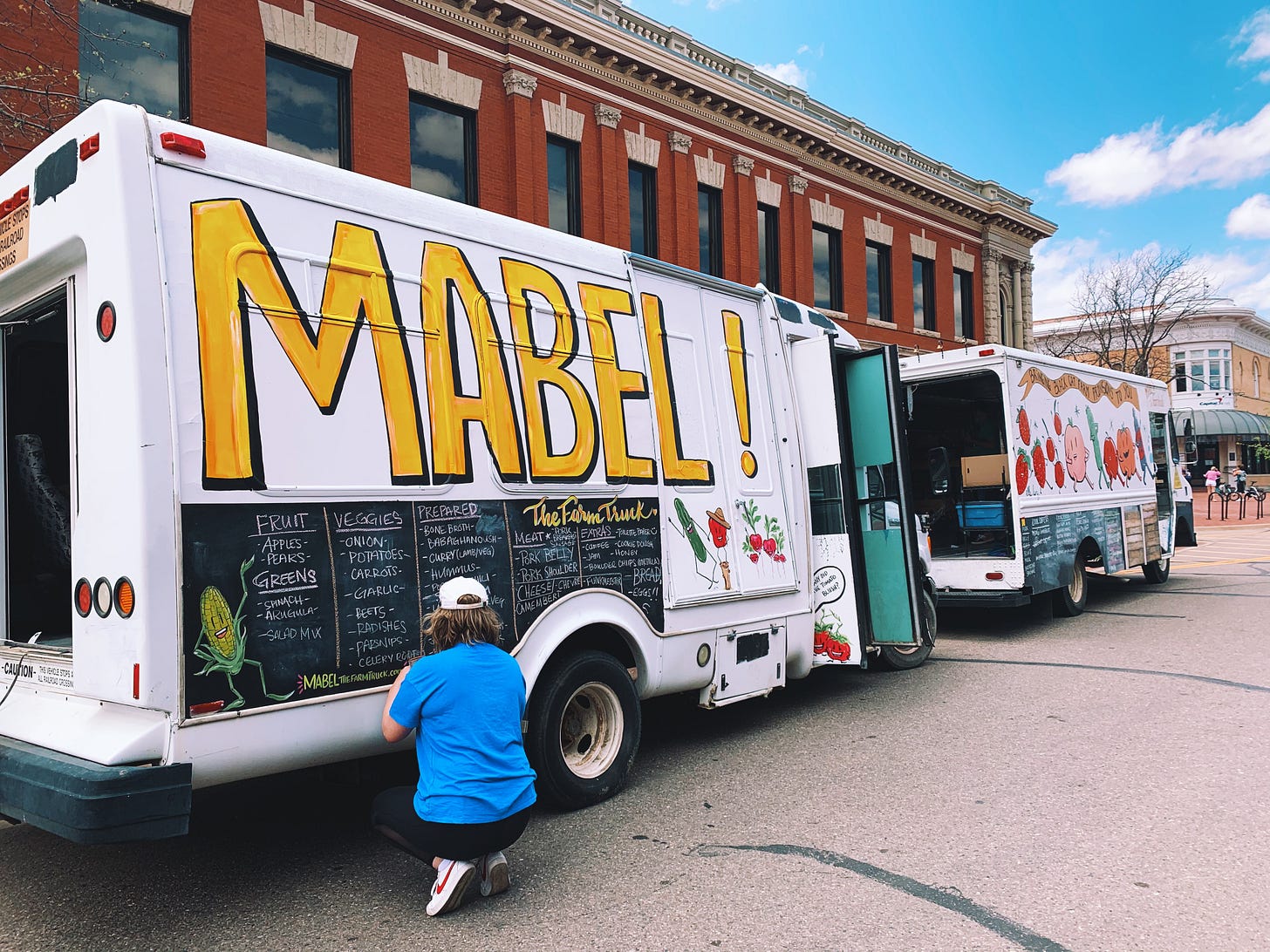
As it was for most restaurants, COVID-19 upended their business. They shuttered the restaurants, and have not opened them since the end of March 2020. Meanwhile, just as they closed the restaurants the fields were bursting with green life. Sheep and pigs needed to be processed.
They needed outlets for their food. Otherwise, immense investments in farming would be lost.
First came a permanent farm stand, a large metal barn used for hay storage along a busy intersection. Firefighters kept a few trucks in there. Suddenly, Black Cat was a grocery store.
Then Eric and Jill bought vintage delivery trucks, affixed bells to them, called them Mabel and began piloting the jingly-jangly trucks down city streets. Instead of popsicles, they sold organic produce and cuts of meat from their farm, local honey, toilet paper (remember those days?). Their plucky ingenuity amidst such restaurant chaos persuaded Good Morning America to Zoom-interview Eric. When he discussed his pride at managing to hire back most of the people he laid off immediately after the stay-at-home order, he cried.
In late June, they launched farm dinners on their farmstead. Night after night the dinners, at tables scattered across the farm with stunning mountain views amidst a pastoral idyll, sold out.
As fall approached, the farm team began crafting cabanas out of iron and glass Eric scored from abandoned greenhouses; Denver was a center for carnation cultivation, indeed was known as the Carnation Capital of the world, until the 1970s. Lots of greenhouse glass is scattered across the Front Range. It is like Eric to pick up piles of it, “just in case” he might need old panels of glass some day.
In the fall cold temperatures drove people back indoors and restaurants effectively lost their outdoor seating. At about the same time, the state diminished the number of guests restaurants could seat indoors, due to rising COVID cases.
Black Cat farm dinners never slowed down. The cabanas were warm, even when temperatures plunged into single digits. The setting offered extreme privacy and safety, while surrounded by atmospheric beauty — the historic barn, silos, views of snow-topped mountains, strutting chickens, waddling geese, heart-meltingly-gentle guard dogs angling for neck scratches and head pats (the gentle act vanishes the instant a livestock predator threatens). The processions of from-the-farm courses compelled diners to take photos and post them on Instagram with happy emojis.
I don’t know if Eric and Jill will re-open Black Cat Bistro and Bramble & Hare once this miserable pandemic recedes. We haven’t discussed it. For now, they are focused on everything else. I do understand, however, that after more than a decade of building community around their many food-related efforts they aren’t going anywhere. We all benefit from their day-after-day toil on behalf of soil, food, hospitality and people.
The Boulder Chamber of Commerce this year awarded Black Cat the Virginia Patterson Business of the Year award. Given the struggles Boulder businesses endured during the year of COVID, this honor seems especially meaningful.
I had hoped to craft this piece into something dense with statistics, data and historical analysis revealing things about what we mean by “farm to table.” I wanted to show how the idea of farm-to-table evolved over time, including nods to Alice Waters and Chez Panisse restaurant in Berkeley, references to Carlo Perini’s establishment of the Slow Food movement in Bra, Italy in 1986 and an exploration of development of the USDA Certified Organic program, which began in 1990.
But as I considered the 13-year arc of my time with Eric, Jill and the diaspora of Black Cat employees, I decided to fix instead on the many tentacled creature of agriculture, food preservation and restaurants they hatched, nursed and made strong.
They remain my heroes.
As Eric told me during that first meeting in 2008, back when I was a journalist scribbling notes in a reporter’s notebook and he was new to growing food, “It’s been big dreams and a lot of work.”
May we all work to keep our dreams close, and lean into grit like Eric and Jill.
From Hot Pools of Bubbling Acid to Breakfast Patties
A future LFTF will don headlamps and helmuts and spelunk through the labyrinth of alt-meats and alt-dairy. New products emerge every day. An excellent publication, Vegconomist, covers the beat with savvy and muscle. It’s worth a bookmark. I check it out every day.
I’ve never declared myself vegetarian or vegan, because I’m not. But after years of resisting any dietary restrictions, I have embraced the animating force behind the term climatarian. Basing food choices, at least in part, on their contributions to climate change petitions for the dramatic mitigation if not elimination of meat consumption. There’s no way around it: raising meat at scale, even if it’s organic, is environmentally devastating.
It was in Vegconomist, one of my fresh guides for climatarianism, that I learned about Nature’s Fynd, a new meat alternative leveraging the power of microbes from Yellowstone National Park. The R&D involved isolating a microbe, Fusariaum strain flavolapis, from highly acidic hot springs and using it to create a nutritional fungi protein the company calls Fy. Growing Fy, through fermentation, demands just a fraction of the water, land and energy required to create meat.
I wasn’t one of the alt-meat fanboys who scored a box of breakfast Fy patties. As soon as I come across the product, I’ll give it a shot.
I think it’s cool that the product sold out immediately. Alt-animal products — replacements for meat and dairy — continue to improve every few months, it seems. Even alt-cheeses have pivoted from dreadful — they all tasted like slices and chunks of supple nutritional yeast to me — to acceptable. Some of the cheese-like spreads are downright awesome. Annie makes them all of the time, out of soaked cashews.
Here’s to Fy!
